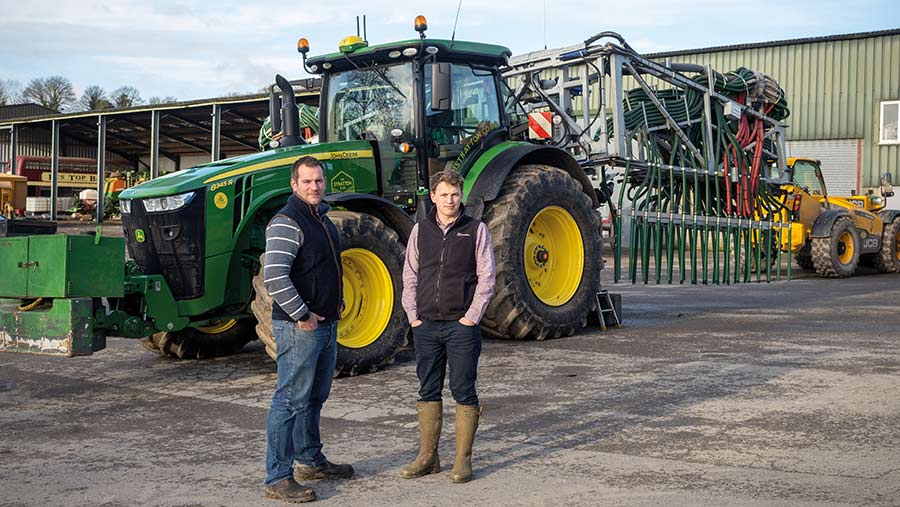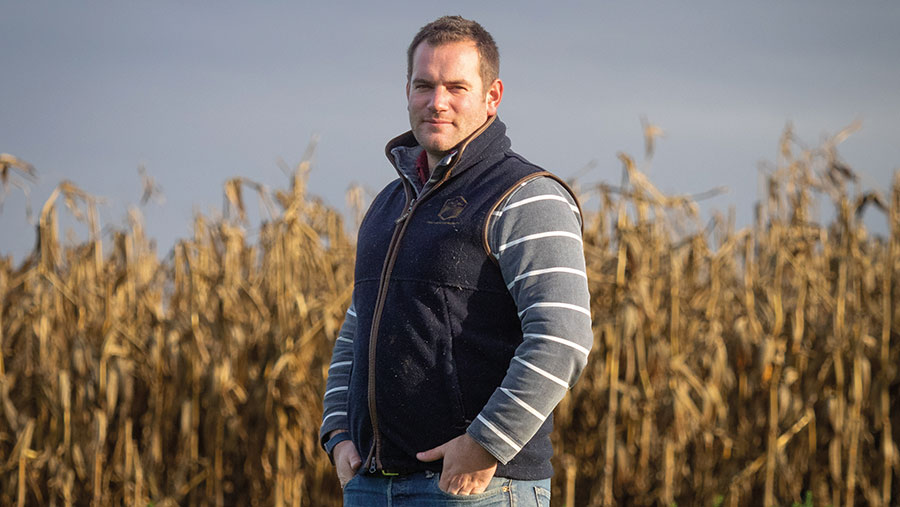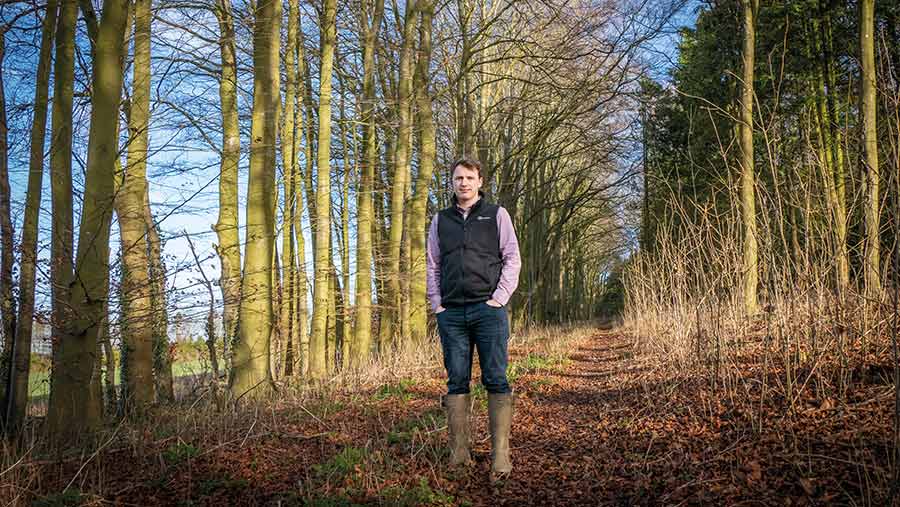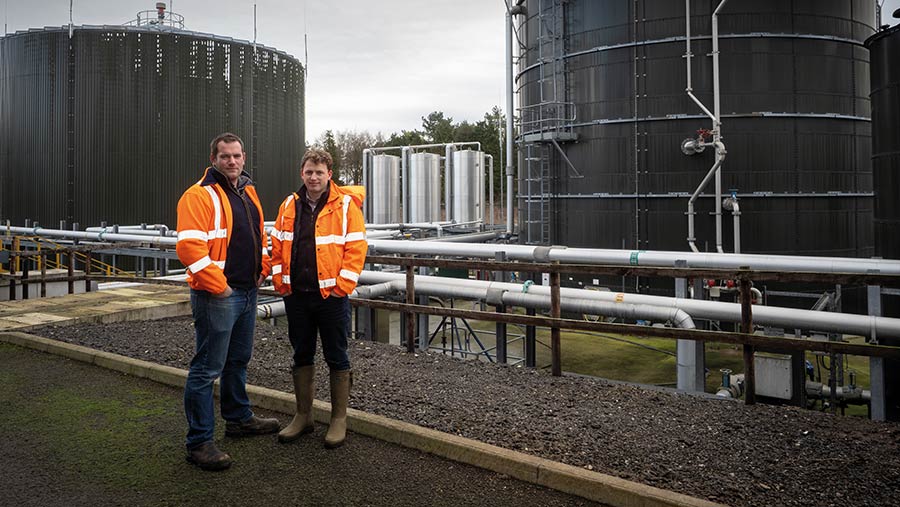Arable business primed for Sustainable Farming Incentive challenge
 Tom Hallett and Ed Shuldham © Kathy Horniblow
Tom Hallett and Ed Shuldham © Kathy Horniblow The concept of “transition” is a familiar one to JM Stratton & Co. from Argentinian-style cattle ranching to dairying, to new arable enterprises, the Wiltshire family business has undergone significant change in the past century.
Today, the focus is on renewable energy and commercial property, alongside the arable land.
Headed by Josh Stratton, the business based at East Farm, Codford, includes 1,800ha of its own land, a contract farming operation, a 3.7MW food-waste anaerobic digestion (AD) plant, field-scale solar PV, and a property portfolio spanning offices, commercial units and residential premises.
“We are a relatively large business, but it’s about what you do with your assets that counts,” says Transition Farmer Ed Shuldham, business development manager for JM Stratton & Co.
“Small, medium and large can all be successful if they’re progressive and managed in right way. It’s about being good at what you do, focusing on detail and involving the right people.”
See also: Sustainable Farming Incentive 2022: What farmers need to know
Farm facts: JM Stratton & Co, East Farm, Wiltshire
- Farm size: 1,800ha
- Combinable crops, grain maize, peas, renewable energy
- Diversification: Events operation; 90,000sq ft let commercial property; 20 cottages and houses
- Annual rainfall: 900mm
- Soil type: Light to medium chalk with patches of clay cap
Sustainable Farming Incentive
“For the past 100 years, every generation here has improved and grown this operation. Every decision is made with the long term in mind.”
One of the most recent initiatives has been putting 364ha in Defra’s Sustainable Farming Incentive (SFI) pilot.
“Most farmers will be involved with the SFI to some extent once it’s fully up and running, so we were keen to establish how we can make it work for us and, hopefully, help shape it for the benefit of all,” says Mr Shuldham.
The SFI fits well with the direction of travel of JM Stratton & Co which, for a decade or more, has been striving for sustainability in tandem with productive farming – concentrating on soil health and implementing measures such as min-till, direct drilling and cover-cropping, alongside straw chopping and digestate spreading.
Transition goals
- Be involved with – and help shape – the Sustainable Farming Incentive
- Make more use of data
- Take natural capital opportunities
Data use
Linked to this is a drive to get ever-smarter with data – what’s collected and how it’s used.
“We’ve made some of the big and perhaps more obvious changes. It’s inevitable, for example, that chopping straw is going to be benefit soil structure and worms, but we need to have more insight now to help us make decisions that move us to the next level.”
The quest for better data use, however, will very much go hand-in-hand with “human” insight and skills.
“People will still be at the heart of this business – a computer will never run the farm. Farmers make decisions based on their instincts, but better information enables those instincts to be better educated.”
This, he says, is partly dependent on the team staying hands-on.
“Tom Hallett, our arable manager, spends lots of time walking the fields, inspecting the crops and the soil. He keeps a worm bible and a weed bible. We want to be able to use technology to build on our existing data collection so we can fine-tune fieldwork.”

Tom Hallett © Kathy Horniblow
Natural capital
Another income stream for the estate could come from the natural capital market – with both the public and private sector likely to pay, for example, for biodiversity net gain or nutrient offsetting and carbon reduction schemes.
Josh Stratton has recently become a director of a new farmer-owned company, the Environmental Farmers Group, which plans to provide natural capital trading in the Hampshire Avon catchment, based on a farmer grain co-op model.
“We have a proven track record in this area of co-operating to deliver landscape-scale environmental projects and Josh was a co-founder of our farmer cluster, the Wylye Valley Farmers,” says Mr Shuldham.
“If a corporate with an ESG requirement to fulfil needed ground for a biodiversity project, the new group could get together a group of farmers to deliver it.”
There are clearly many strands to this business, but they are linked by common themes.

Ed Shuldham in one of the managed woods on the estate © Kathy Horniblow
AD plant
“The principle of circularity and the circular economy is important, with food waste going into the AD plant, the digestate providing fertiliser for the arable land which, in turn, grows food in a way that is working with the environment,” he says.
“Renewable energy is vital and the next evolution of this might be to find some ‘energy-intense’ agricultural tenants – a vertical farming or insect growing business, for instance – that could use our renewable energy as part of the wider farm ecosystem.
“Ultimately, though, the bulk of the assets that this company has is farmland – and agriculture is our core business.”

Tom Hallett and Ed Shuldham (right) © Kathy Horniblow
Ed Shuldham is one of our Transition Farmers. Join him as JM Stratton strives to become financially and environmentally sustainable and overcome the challenges it faces over the next five years.
